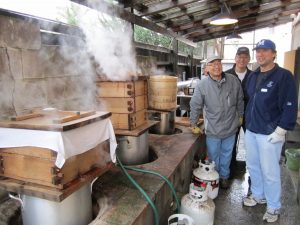This month typically many of our temples make “mochi,” traditional Japanese rice cakes. They hold “mochitsuki,” a special day for making mochi. Unfortunately because of the pandemic, we’ve put this activity on hold. Nevertheless, please enjoy this description of a timeless tradition.
Mochi is made from a “sweet” rice that’s stickier than regular rice. It’s pounded and shaped into a palm size mound and typically used as a dumpling for soup or toasted and eaten with sauce. They also are placed on Buddhist altars at year-end to welcome the New Year.

At Berkeley Higashi Honganji for example, rice kernels are washed and soaked in water several days before mochitsuki. The water is changed every other day, allowing water to fully soak in, which expedites cooking and softens the rice. On mochitsuki day, the rice is steamed in Japanese wooden boxes. After cooking, it’s kneaded and pounded into a doughy blob.

Traditionally, the dough is placed in a big stone bowl-like mortar. A few people may jab the dough with wooden poles to begin kneading. Afterwards, one or two people with wooden mallets pound the dough, while a third person flips it, occasionally splashing on a little water to prevent sticking. This routine takes strength, timing and courage, but it’s a grand tradition and fun to boot.


In Berkeley, the old method still is performed to keep the tradition alive, but it’s time consuming and slow, so electric grinders knead most batches. Afterwards, the dough is pulled apart and shaped entirely by hand, and put out to cool.

Mochi cakes used for Buddhist altars at year-end are called “kagami mochi.” Kagami means “mirror” in Japanese. The mochi tends to be larger than regular mochi and flattened on the bottom end, making them look like old-fashion mirrors.

Mochi is traditional New Year’s food, put in soup (called “ozoni”) and toasted to a crisp and eaten with sauce, such as a mix of soy sauce and sugar.
Besides mochi, regular cooked rice is a traditional offering on Buddhist altars. Rice symbolizes food essential to life, a reminder of our interdependence with all living things.

Decades ago in Japanese American communities in the United States, mochitsuki was more prevalent, held as an annual ritual and community event. Families even made their own mochi at home. Nowadays, the number of people and organizations following this tradition has dwindled, making it hard for mochi connoisseurs, lovers and fans to find it freshly made.
Fortunately, many of our temples still follow this tradition. In Berkeley, temple members make mochi as a fundraiser, producing more than 900 pounds in a single day and sometimes selling out before they’re done.

Hopefully next year, you can experience mochitsuki at one of our temples. Happy mochitsuki!
-Rev. Ken Yamada
Editor, Shinshu Center of America

